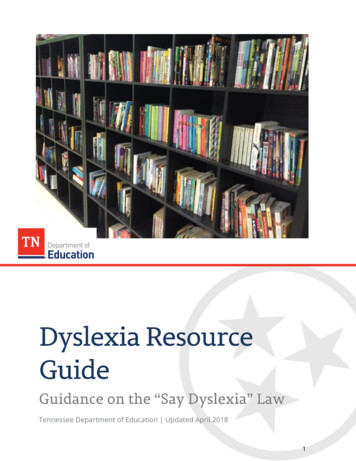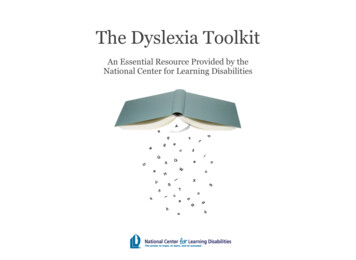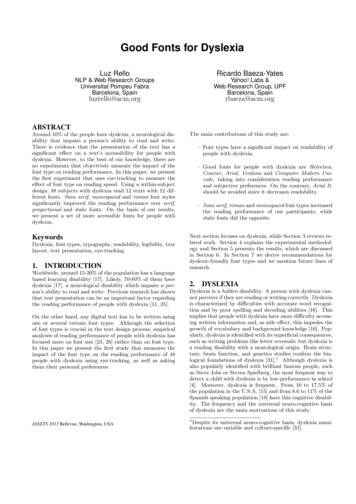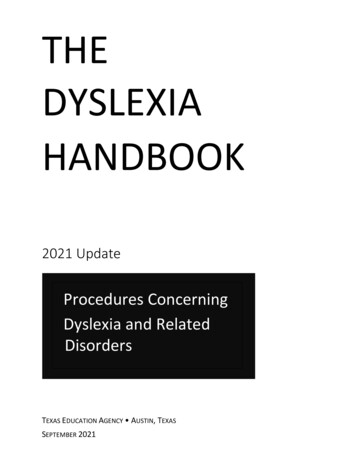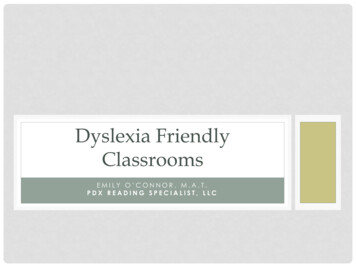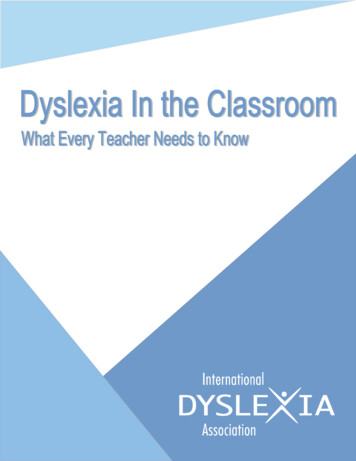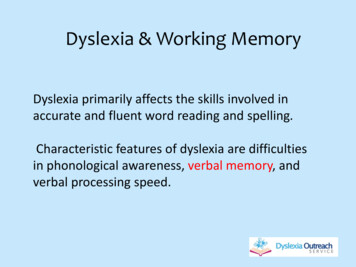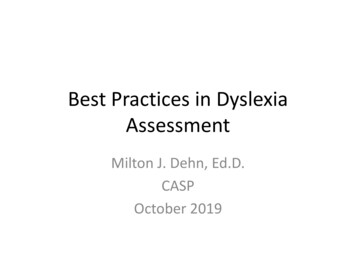
Transcription
Best Practices in DyslexiaAssessmentMilton J. Dehn, Ed.D.CASPOctober 2019
Copyright NoticeThis PowerPoint is copyrighted 2019 by Milton J.Dehn and Schoolhouse Educational Services, Inc.All rights reserved. No photocopying, electronicdisplay, or electronic dissemination is allowedwithout written permission. For permission,contact milt@psychprocesses.com.
Main Sources of Information Essentials of Dyslexia Assessment andIntervention, Mather & Wendling Essentials of Assessing, Preventing, andOvercoming Reading Difficulties, Kilpatrick Psychological Processing Analyzer, Dehn Reynolds Early Assessment of Dyslexia (READ) Reynolds Dyslexia Risk Questionnaire (RDRQ)
Workshop Content1. What is dyslexia2. Different types of dyslexia3. Orthographic processing4. Brain basis of dyslexia5. General assessment recommendations6. Related neuropsychological processes7. Specific processes to assess8. Using PSW to identify dyslexia9. Newer, specific scales to use10. Case study
Dyslexia Definition“a neurobiological disorder that causes amarked impairment in the development andbasic reading and spelling skills”
IDA Dyslexia Definition“Dyslexia is a specific learning disability that isneurobiological in origin. It is characterized bydifficulties with accurate and/or fluent wordrecognition and by poor spelling and decodingabilities. These difficulties typically result from adeficit in the phonological component of languagethat is often unexpected in relation to othercognitive abilities and the provision of effectiveclassroom instruction. Secondary consequencesmay include problems in reading comprehension ”
IDEA Inclusion of Dyslexia Under SLDSLD is “a disorder in one or more of the basicpsychological processes involved inunderstanding or in using language, spoken orwritten, that may have manifested itself in theimperfect ability to listen, think, speak, read,write, spell, or to do mathematical calculations,including conditions such as perceptualdisabilities, brain injury, minimal braindysfunction, dyslexia and developmentalaphasia.” DSM-V also has it under SLD types.
CA CDE Guidelines1. Dyslexia is a specific learning disability, but adyslexia diagnosis does not automaticallyqualify for SLD2. May be served in regular ed3. Mentions processing disorders, phonologicalprocessing, and neuropsychologicalprocesses, such as rapid naming4. Mentions psychs understand PSW
Dyslexia vs Reading Disability1. Is it not the same thing as a specific learningdisability in basic reading skills?2. Most parents think it’s something different3. Most educators think it’s somethingdifferent.4. Many experts think it’s the same.5. All 50 states now have separate dyslexialegislation, many indicating that it somethingdifferent than an SLD in basic reading skills
How Dyslexia is Different1. It’s not just an IQ – Achievement discrepancy2. There are clear neurological weaknesses3. Phonological and/or orthographic processingweakness(es) should be present4. Spelling weakness is present5. The reading problem is more severe andresistant to intervention
Dyslexia Misconceptions1. It’s a visual problem only.2. It’s a problem recognizing individual lettersand their phonemes.3. It’s seeing and reading letters/wordsbackwards.4. It’s different than a “reading” disability
Dyslexia Subtypes1. Deep (Dysphonetic Dyslexia/PhonologicalDyslexia) – problems applying phonologicalrules and a weakness in phonologicalprocessing; difficulty with nonword reading2. Surface (Orthographic Dyslexia/DyseideticDyslexia) – low sight word vocabulary, weakreading of irregular words, slow rate, spellingerrors, especially with irregular words3. Mixed – both surface and deep
Dyslexia Subtypes Controversy1. Some research says there are no subtypes2. The most appropriate diagnoses in mostcases may be “Mixed”
Mixed Dyslexia1. Phonology enables the initial formation ofword representations2. Orthography provides more detailedrepresentations that are the gateway tohighly skilled reading3. Consistent with dual route theory
Phonological and OrthographicRelations1. Younger children rely more on phonological2. Older children more on orthographic3. But some basic orthographic mapping beginsearly, before phonetic decoding4. Vary depending on whether language istransparent (spelling is mostly phonetic) oropaque (English)5. Strong vocabulary may mask weaknesses ineither one (context will help)
Reading Fluency1. Does not seem to be a stand-alone readingdisability2. It depends on a large sight word vocabulary,which depends on orthographicprocessing/memory3. Oral reading fluency is usually a weakness indyslexia
Orthographic Processing“the ability to visually recognize and rememberprinted words and parts of words. It includes theability to recognize letter sequences and patternsand to spell phonetically irregular words”1. Considered a specific ability that is oftendeficient in dyslexia2. Different from broad visual-spatial processing3. Orthographic is specific to symbols/letters4. Now stands alone Dehn’s PSW software5. Not listed in CHC model
Orthographic Processing and Reading1. Orthographic is recognizing words and partsof words by sight, such as prefixes, suffixes,and roots2. Necessary for1. Reading decoding/basic reading skills2. Reading fluency3. Written expression (spelling)3. Not a direct influence on reading comp.
Orthographic Mapping1. Process of turning unfamiliar written words intoinstantly accessible sight words2. This mapping determines whether readers will easilyremember the words they see3. Normal readers map a new word in as few as 1-4exposures4. Dyslexic readers: it takes many, many exposures 105. Phonics helps identify unfamiliar words but does notnecessarily promote instant word recognition6. Good working memory, especially visual-spatial maysupport orthographic mapping
Orthographic Mapping Requires1.2.3.4.Advanced phonemic awarenessLetter-sound knowledgePhonological long-term memoryThe oral pronunciations of words already storedin long-term memory are the anchoring pointsfor the orthographic sequences5. Phonic decoding is part to whole6. Orthographic mapping is whole to part
Orthographic Memory1. Stored phoneme sequences are aligned withprinted letter sequence2. We do not store words according to theirvisual properties but rather the alignment ofthe letter sequence and the phonemesequence in the word’s pronunciation3. Recalls common spelling patterns such as“tion” and “ight”
Orthographic Knowledge1. What is permissible and not permissible inEnglish language spelling, such as “ight”versus “tbl” or triple letters2. Learning the common letter patterns such asing, ed, tion, ough
The Brain and Dyslexia
The Brain and Dyslexia1. Inefficient functioning of left posterior readingsystems2. Less use of the parietotemporal wordanalysis/phonics area3. Less use of the left occipitotemporal areareferred to the “visual word-form area”1. Functions as a memory area2. This integrates phonology and orthography, but howis unknown4. Dyslexic brains process information slower
Orthographic Mapping1. Is in the fusiform gyrus, an area that overlapsthe temporal and parietal lobes in the lowerpart of the cortex in both hemispheres2. This is where letter sequences are stored andretrieved from3. In dyslexics the left fusiform gyrus is not veryactive4. All the letters in a word are then perceived ina single glance
Fusiform Gyrus
Fusiform Gyrus“The fusiform gyrus, also known as theoccipitotemporal gyrus, is part of the temporallobe and occipital lobe. Though the functionalityof the fusiform gyrus is not fully understood, ithas been linked with various neural pathwaysrelated to recognition. Additionally, it has beenlinked to various neurological phenomena suchas dyslexia” Also, face recognition area
Genetics1. If parent has dyslexia, 30-50% of the childrenwill2. If one child has, 50% of siblings will3. Both phonological and orthographic deficitshave a strong genetic component4. However, orthographic processing/memorydevelopment are at least partially dependenton exposure to symbols and print
Ranking of Strengths to Weaknesses inDyslexia (Kilpatrick)1.2.3.4.5.6.IntelligenceListening comprehensionReading comprehensionDecoding words in contextDecoding words in listsNonsense word reading and spelling
Dyslexia AssessmentRecommendations1.2.3.4.Test phonologicalTest orthographicTest spellingOral reading fluency will be weak if it is dyslexia,but no need to directly test it5. Reading comprehension will be limited todecoding level, but no need to directly test it6. Test related neuropsychological processes7. Follow a PSW model for dyslexia testing
Reading Skills to Assess for Dyslexia1.2.3.4.5.6.Letter RecognitionWord RecognitionSpellingDecodingReading FluencyComprehension
Assess Neuropsychological ProcessesHighly Related to Dyslexia1. Phonological2. Orthographic3. Auditory4. Oral Language (Morphological Awareness)5. Processing Speed6. Verbal Long-Term Recall7. Visual-Spatial Long-Term Recall8. Rapid Automatic Naming9. Verbal Working Memory10. Visual-Spatial Working Memory(Basically the same processes as those needed for Basic Reading Skills)How it compares to other SLD categories Link
PSW and Dyslexia1. A pattern of cognitive strengths andweaknesses2. Look for processing weakness that arerelated to the learning weakness3. Cognitive weaknesses cause, are associatedwith/account for the learning problem
Dyslexia Processing Deficits1.2.3.4.5.Auditory and Visual-Spatial are too broadAre often average in those with dyslexiaNarrow abilities are betterPhonological instead of auditoryOrthographic instead of visual-spatial1. Orthographic is more specific to symbols---thealphabet and sequences and patterns of letters
Orthographic vs Visual Processing1. Visual-Spatial involves shapes, designs,pictures, objects, location2. Orthographic is specific to letters and wordsand symbols that represent words
Phonological Awareness1. Ability to perceive and manipulate the speechsounds that make up words2. Words, syllables, and phonemes3. Phonemic Awareness1. Aware of and manipulation of phonemes2. 42-44 in EnglishHow many ways can you spell 44 sounds in AmericanEnglish?The answer is why English is an opaque language thatchallenges both phonological and orthographic.
Phonological Assessment1. Nonsense words are ideal2. Phoneme segmentation is the least sensitivephonological assessment task3. Blending is slightly better4. Manipulation is the best: replacing, deleting,reversal
Levels of Phonological Processingin Order of Difficulty eleting (Elision)ReplacingMay do fine with rhyming, segmenting, andblending, but poorly on deleting and replacing1. Note which type required by the test when usingPhonological scores for diagnosis
Processing Speed1. Processing speed affects reading rate andautomatic word recognition2. May explain link between RAN and reading
Dyslexia and Working Memory1. Well-established connection, (see Dehnarticle) but may have average WM2. An average WM can be overloaded during acumbersome decoding and retrieval process(too much cognitive load)1. May forget sounded out phonemes before theycan be blended3. A long-term memory storage and retrievalproblem also adds to cognitive load
Dyslexia and Long-Term Memory1. They can’t remember pronunciation andspelling of phonetically irregular words2. Dehn’s Observation: Long-term memory forwords is not organized phonetically1. E.g., can’t name words that begin with a specificphoneme
Rapid Automatic Naming1. Ability to name familiar objects, symbols, orletters quickly2. A specific type of long-term recall3. Deficits associated with reading problems4. Is the second part of the “double deficit”5. Is especially related with orthographicreading---reading phonetically irregularwords
Dyslexia and Memory1. All types of memory processes are importantfor reading2. A deficit in one or more memory processes isfrequently related to dyslexia3. Link See memory subprocesses from theMemory Processes Analyzer
Morphology“In linguistics, morphology is the study of words,how they are formed, and their relationship toother words in the same language. It analyzesthe structure of words and parts of words, suchas stems, root words, prefixes, and suffixes.Morphology also looks at parts of speech,intonation and stress, and the ways context canchange a word's pronunciation and meaning.”
Morphology and the PPA1. Part of morphology is recognizing how wordparts such as prefixes and suffixes change themeaning of a word2. Morphology is part of oral language3. Can use scores from speech therapist4. Enter under PPA Oral Language area as anunlisted score if necessary5. Normally developed morphology can supportorthographic processing
Assessing Orthographic Processing1. Spelling, especially phonetically irregularwords2. Letter-pattern matching3. Word reading fluency, especially phoneticallyirregular words (should be timed)4. Memory for words and word patterns5. Special “orthographic” subtests6. See PPA list
Irregular Words1. Even phonetically irregular words typically haveonly one irregular letter-sound relationship,such as island2. More than one irregular relationship in a word isunusual, e.g., words such as “one” which ispronounced as wun3. When teaching irregular words, they should beanalyzed and the parts that are phoneticallyregular and irregular should be pointed out
TOWRE-21.2.3.4.Test of Word Reading EfficiencyHas timed nonsense word reading subtestand timed reading of real wordsIf untimed, examinee can decodephonetically5. May be too easy for older students6. KTEA-3 Decoding Fluency subtest is similar
KTEA-3 Orthographic Processing1. Spelling2. Letter-Naming Facility3. Word Recognition Fluency
TIWRE1. Test of Irregular Word Reading Efficiency2. Uses only irregular words3. But is not timed
TOC1.2.3.4.Test of Orthographic Competence (TOC)Several subtestsBased on tasks in research studiesIncludes a homophone choice task, such as,“Which is a flower, rose or rows?5. Has Signs and Symbols subtest
Spelling Tests1. Pay attention to irregular words2. Is the spelling mainly phonetic3. If irregular words are worse, points to anorthographic processing weakness4. Spelling nonsense words (WJ IV) requiresprecise spelling (only one option is correct)
Word Identification Tests1. These are sight word tests, regular, irregular,and nonsense words2. Ideally should be timed to reduce reliance onphonetic decoding3. If the student has the sight word inorthographic memory, the word will beconsistently pronounced correctly, instantly,and effortlessly without needing context
Feifer Assessment of Reading (FAR)Phonological IndexPhonemic AwarenessNonsense Word DecodingIsolated Word Reading FluencyOral Reading FluencyPositioning Sounds
FARFluency Index (this is mostly an orthographicfactor)Rapid Automatic NamingVerbal FluencyVisual PerceptionIrregular Word Reading FluencyOrthographical Processing
FARComprehension IndexSemantic ConceptsWord RecallPrint KnowledgeMorphological ProcessingSilent Reading Fluency: Comprehension
The READ (Reynolds EarlyAssessment of Reading)1.2.3.4.5.6.An early dyslexia screenerAges 4-8Computer-assisted administrationThis scale is being standardizedWill be available in early 2021Published by Schoolhouse EducationalServices
READ Subtests1. Print Conventions2. RAN: Letter Naming3. Semantic Sequential Recall4. Orthographical Processing5. Basic Language Concepts6. Letter Recognition7. Word Recognition8. Phonemic Awareness: Elision9. Phonemic Awareness: Blending
Reynolds Dyslexia Risk Questionnaire(RDRQ)1.2.3.4.5.6.7.A rating scaleIdeal for universal screeningForms for ages 4-5 and 6-7Both parent and teacher formsForms have 45-60 itemsCan complete in less than 10 minutesHelpful with young children who are not verytestable
Case Study I1. Grade 5; beginning 1st grade reading level2. Average intelligence with mid-averagevocabulary and above average visual-spatial3. Also has Autism4. Spelling is extremely low – 0.1 percentile5. Painfully sounds out each word even thosethat should be simple sight words (phonicstraining has been emphasized with him)
Case Study PPA Results Orthographic processing deficit supportsdyslexia diagnosis when matched with BasicReading Skills score of 56 See PPA results table
Case Study I Recommendations forOrthographic Processing Weakness1. Place emphasis on phonics instruction2. When teaching basic sight words, discouragehim from trying to sound out the word. Rather,encourage him to look at the whole word andtry to recognize it as a whole.3. Do more rehearsal/repetitions of whole wordsas they are read, especially when a correctionwas needed4. Practice word families, such as all the words thatend with “ack”5. More reading experience
Case Study II1.2.3.4.5.6.7.8.Middle of 2nd GradeNew words do not stickDifficulty recognizing some letters and their soundsFather had dyslexiaAverage GIA on WJ IVAverage Oral Language on WJ IVSpelling on WJ IV at 8th percentileBasic Reading Skills at 9th percentile1. Letter-Word – 752. Word Attack – 879. Poor response to reading interventions
Case Study II PPA Results
Case Study II: Phonological Processing WJ IV Phonetic Decoding – 98 (consists ofSegmenting and Blending) Phonological Processing – 85– Low due to poor recall of words that begin with aparticular phoneme
Case Study II FAR ResultsIsolated Word Reading FluencyPositioning SoundsVisual PerceptionIrregular Word Reading FluencyOrthographical Processing6284887391
Case Study II: FAR Isolated WordReading Fluency - 62 This is a phonological subtest withphonetically regular words
Case Study II: FAR Irregular WordReading Fluency - 73Examples:EyesOnionCalmDoubtCoughAisle
General Assessment Strategies andRecommendations1.2.3.4.5.Listen to the child read, at least informallyConsider risk factorsConsider other disorders, ADHD, Autism, etc.Rule out ELL and exclusionary factorsIf does not meet new dyslexia criteria, maystill meet reading disability criteria
Sharing Results with Parents1. Deal with the myth that it’s all about seeingletters and words backwards2. Discuss the brain basis & processingweaknesses3. Include strengths4. Emphasize the need for intensive earlyinterventions5. Discuss interventions which lack evidencebase, such as colored transparencies
Intelligence 2. Listening comprehension 3. Reading comprehension 4. Decoding words in context 5. Decoding words in lists . 10. Visual-Spatial Working Memory . 3. A long-term memory storage and retrieval problem also adds to cognitive load. Dyslexia and Long-Term Memory 1. They can't remember pronunciation and
